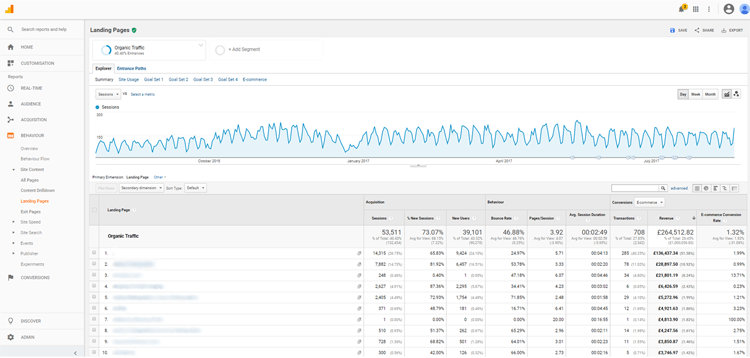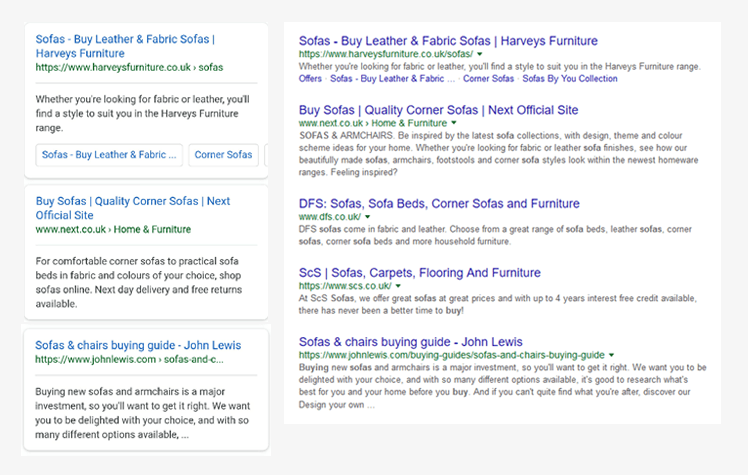Ecommerce SEO Migration Checklist To Avoid Disaster
So you’re going to redesign your ecommerce website or move to a new platform? Without an ecommerce SEO migration strategy, a new ecommerce website can result in a massive loss in SEO rankings, SEO traffic and precious ecommerce SEO revenue.

However, whether you’re moving to Magento 2, Shopify, BigCommerce, SiteCore or a custom build, there are a number of steps you can take to mitigate against the SEO risks of a new ecommerce website. As well as enjoy the longer term benefits of a major uplift in ecommerce SEO revenue in the process.
From successfully leading over 100 SEO website migrations including migrating 25 separate international domains into one global domain for The Body Shop, we've compiled this ecommerce SEO migration checklist to make sure you don’t destroy your ecommerce SEO revenue overnight.
1. Migrate your website off peak
The best way to ensure you don’t kill your ecommerce sales for the year is to plan your website migration in your off peak selling period.
For example, if your business relies on Christmas sales that start from September/October, you ideally want to have 3-6 months between your new website launch and your peak trading months. That means you don’t want to be going live any later than May/June and ideally as early as February/March (unless Valentine’s Day and Mother’s Day are also peaks for your business).
2. Benchmark indexed pages
To find out how many of your website pages are already indexed in different search engines such as Google.co.uk, Google.com, Google.ie and Bing.com, enter the following search parameter using your actual website’s domain into the search box:
site:mydomain.com
So instead of “mydomain.com” put your website address without the https://www.

site:mydomain.com example screenshot3. Benchmark SEO keyword rankings
Use a keyword ranking tool such as Authority Labs to benchmark your current SEO keyword ranking positions in different search engines including Google and Bing.
4. Benchmark SEO traffic
Use a traffic analytics tool such as Google Analytics to benchmark how much traffic the site has received from SEO (Organic Search) for the last 12 months. Benchmark the SEO traffic volumes both for the year in total and broken down on a monthly basis to see where the seasonal peaks and troughs are.

5. Benchmark ecommerce SEO revenue
If you’re using Google Analytics and have Ecommerce Tracking set up, you can see the last click revenue attributed to SEO within the same SEO channel report. Benchmark the SEO revenue for the year in total and broken down on a monthly basis.
6. Benchmark advanced ecommerce SEO metrics
If your site is generating hundreds of thousands or millions of pounds in revenue from ecommerce SEO already, you should also break the ecommerce SEO revenue benchmarks down further into the following metrics:
- Ecommerce SEO assisted revenue
- Ecommerce SEO conversion rate
- Ecommerce SEO average order
- Ecommerce SEO revenue per visit
- Ecommerce SEO average number of visits to purchase
- Ecommerce SEO average number of days to purchase
- Ecommerce SEO revenue split of total ecommerce revenue
7. Benchmark your domain authority score
Use a link analysis tool such as Ahrefs to assess your website’s current domain authority score. Your DA score is a measure of the equity within your current domain and is representative of how search engines evaluate how high in the search engine results pages your site should appear. The higher the score, the higher the placement.
Switching off an internal link to a product page that is currently ranking at position 1 in Google, could drop that ranking and immediately switch off thousands in revenue overnight
When your website migration goes successfully and you’ve not changed any of your URLs, all of your historic ecommerce SEO value will be passed across to your new site and your score should remain the same as before.
If you find your score has dipped unexpectedly, then you can use this benchmark to identify that there has been a loss and take action to rectify the situation.
If you’re migrating multiple websites into one new master website then you should expect that your DA score increases.
8. Benchmark revenue split by mobile vs desktop vs tablets
Use your analytics to create a benchmark of the split of revenue by device type from the last 12 months broken down by month and year. As improving responsive design is often the reason behind many website migrations, being able to demonstrate the new site’s mobile ecommerce performance is better than the old site will prove the migration as a success post launch.
9. URLs
If you can avoid changing any URLs that will always be the preference for maximising your ecommerce SEO performance.
Yes you can redirect old URLs to new URLs, but every time you do a small amount of the SEO equity that makes up your domain authority score is lost. So if you rewrite 1,000s of URLs in your website migration, cumulatively that would likely result in a lower domain authority score post launch. A lower domain authority will result in a drop in rankings across all keywords, meaning your SEO traffic will reduce and with it, your ecommerce SEO revenue.
Adding insult to injury, every time you change a URL, Google will need to remove the old URL from it’s index, re-evaluate the new URL and re-index that new URL back into the search results. Therefore as well your rankings, traffic and revenue decreasing in the short term, you may also completely lose your previous ranking positions because the keywords that were in the URL have been removed or are lower in the site architecture than before.
On the plus side, you may start to rank for brand new keywords you never ranked for before instead, but to prevent any losses, just keep the URLs exactly as they were.
10. Navigation
Your navigation is usually found at the top of the page and contains links through to all your category pages. Search engine spiders crawl these links and you will find that it is very likely that you rank well in Google and Bing for keywords that relate to how you have labelled your navigation.
When migrating to a new website design, proceed with extreme caution in making any changes to the navigation naming conventions. Renaming navigation or changing how the navigation is displayed could mean instant removal of the keywords that are sending you your best ecommerce SEO revenue at the moment.
11. Site architecture
Whilst the navigation is the way your website menu is presented to users and search engines, your site architecture is how your pages are organised. The higher a page appears within your site architecture the more weighting Google gives to that page and the higher it will rank that page. Similarly, if you move the level of the page down in the architecture, Google will place less value on it and you will rank lower for the keywords you were ranking for before. Of course, the lower you rank the less traffic and revenue you will get.
Therefore, if you currently have a category page at level 1 in your site architecture at “yourdomain.com/beds” and you move it down to level 2 to “yourdomain.com/furniture/beds”, Google will lower your ranking for that page.
So if you’re happily ranking on page 1 in Google’s search results for keywords such as “beds” now, do not change the architecture of your site or you will very likely drop off page 1 and immediately stop any ecommerce SEO revenue you got from that ranking before.
12. Internal links
Search engine spiders index the world’s website pages by following links. Making any changes to your current internal links will immediately change the value that the search engines place on the pages that are being linked to.
Removing any internal links would very likely mean you lose SEO rankings, traffic and revenue from the pages that were previously being linked to. To prevent any losses in ecommerce SEO revenue, make sure you keep all previous internal links going to the same pages as before, or to the next best possible page if the same page is no longer available.
What’s especially important to repopulate, are links within category pages and blog pages that are usually linking through to sub category pages and product pages.
Product pages typically have the highest conversion rates from SEO. So switching off an internal link to a product page that is currently ranking at position 1 in Google, could drop that ranking and immediately switch off thousands in revenue overnight.
13. Meta Data
Meta data including title tags and meta descriptions are one of the most forgotten elements in a website migration, unfortunately they are one of the most critical for a smooth ecommerce SEO migration.
Category meta data and blog meta data are often responsible for driving the highest volumes of relevant customers to an ecommerce site via SEO.

When moving to a new platform, your data migration often includes migrating product content and its associated meta data.
Category meta data, static page meta data (such as your homepage, delivery page, about page) and blog meta data migration are often excluded. Which means you may either need to manually copy and paste your old meta data into your new site, or specifically request a custom development to migrate all types across.
Just make sure that every keyword across your category, product, blog and static page meta data is in exactly the same place as before and you can prevent against any drops in rankings, traffic and ecommerce SEO revenue post go live.
14. Content
Any changes to the written copy will result in changes to your current rankings, traffic and revenue.
Using your website migration as an opportunity to improve your ecommerce SEO by adding in new keyword gaps would help to increase the number of keywords your site is found in Google for and grow revenue. However with so many changes taking place at the same time, the lowest risk approach would be to migrate your site without making any content changes.
Then you can properly assess the impact of the new design and then systematically roll out new content changes post launch when you can test what version of your content performs best.
15. Images
When moving to a new site, there may be an opportunity to improve the current image optimisation by including relevant keywords within the image file name and alt tags.
Although if your current site has some optimised images, keep these exactly the same to avoid any losses in rankings, traffic and revenue. Images are often shared on social media and appear in Google image search results so changing the names of the images could break the image paths back to the new site leading to broken links and a loss in ecommerce SEO revenue.
16. User Experience
A good reason for a new website design is to improve the current user experience, however even with the best intentions a beautiful new design may convert at a lower conversion rate than before.
So by keeping all the other elements of the website the same in the migration, particularly the content you will more easily be able to identify the uplift from the new design (or the drop off).
17. Reviews
Another critical factor in ecommerce conversion rates is the volume and average rating of reviews you have for each of your products. Make sure you can port across your reviews to the relevant pages of your new site or it’s likely that your conversion rate will drop and even if you maintain the same traffic from SEO as before, you will get less ecommerce SEO revenue.
For maximum ecommerce SEO benefit make sure your new site requirements include coding your onsite reviews for Google Rich Snippets. Then as many pages as possible will feature in the search engine results pages with 5 star reviews in the search result, which has been proven to increase click through rate, driving more traffic and ecommerce SEO revenue from every page ranking in Google.

18. Codebase
If you are migrating ecommerce platforms from Shopify to Magento 2, or Magento to BigCommerce then your website code will change.
A critical factor of technical SEO is how easily search engines can crawl your website code. Moving to a new platform may be easier for your team to administrate but it might turn out to be more cumbersome for search engines to crawl and index. This could result in a drop in rankings, traffic and revenue across the site.
So to mitigate against this, use Google Page Speed Tool to evaluate your site before and after the migration and get your developers to follow the recommendations for improvements.
19. Redirects
If you do have to change any URLs then you will need to have a permanent 301 redirect in place for every page.
Don’t just redirect every page to the homepage or you’ll be making the path for both users and search engines far less relevant. And if you didn’t guess by now, that will result in a loss of rankings, traffic and revenue.
You can use a free redirect checker to make sure your redirects are redirecting correctly and using permanent 301s and not temporary 302s. You need to watch out for 302 redirects as they behave like 301 redirects to a user but pass on absolutely no value from an eCommerce SEO perspective. And yes, that will lead to a loss in rankings, traffic and revenue.
20. Sitemap
As part of your new website requirements, having a XML sitemap at the best practice location of yourdomain.com/sitemap.xml would be ideal. Then as soon as the new site goes live you can add your new sitemap into your Google Search Console and Bing Webmaster Tools accounts and invite the search engines to recrawl your site ASAP.
You can then monitor for any issues and work with your development team to sort out any 404 errors or redirects that have gone awry.
Make sure it’s all hands on deck for the day of your site migration and don’t let any project stakeholders disappear off anywhere for at least a few business days afterwards. You’ll need to complete live testing and check every page is as it should be.
21. Custom 404 page
Another website requirement that you will need to maximise your ecommerce SEO is a custom 404 page.
Then just in case any user or search engine spider ends up on an old page that hasn’t redirected correctly or happens to follow a link from the search results in the middle of the move, they will instead land on this page.
To enable the user or search engine spider to continue their journey from where they were expecting to arrive and where you want them to go, you should include the following on your custom 404 page:
- Text link to the homepage - to enable search engine spiders to continue to crawl your site so as many pages of your site are included in search results as possible
- Search box - to enable users to find the page they wanted and go on to buy the product they were looking for (or something similar)
You can also include text links to popular pages, your main navigation and a friendly message. But ignore the text link to your homepage and search box at the peril of your eCommerce SEO revenue!
22. Analytics
Before you migrate to your new site, brand, platform or domain do use the same Google Analytics account code as your old website. That way you will have a seamless transition and be able to easily compare your new SEO traffic, ecommerce SEO revenue and other SEO metrics from before and after your migration.
23. Robots.txt
After your new website has migrated, do check your yourdomain.com/robots.txt file to see that there are no “disallow” lines of code left in post launch that shouldn’t be there.
It is very common for ecommerce agencies to hide your new site from being indexed whilst its in development which makes perfect sense. This is also the most popular reason we receive emergency calls from frantic entrepreneurs and marketing teams after their ecommerce SEO revenue has dropped off a cliff after go live.
Final ecommerce SEO migration thoughts
The impact of your website migration on your ecommerce SEO may not be seen straight away as it depends how quickly Google and other search engines come back to recrawl your site.
You will typically start to see some impact straight away but the repercussions of your ecommerce SEO migration will be felt for many months afterwards. So we recommend that you continue to monitor your SEO rankings, traffic and revenue against your benchmarks and use this checklist to identify any issues.
For further ecommerce SEO migration advice please get in touch for a free consultation.

